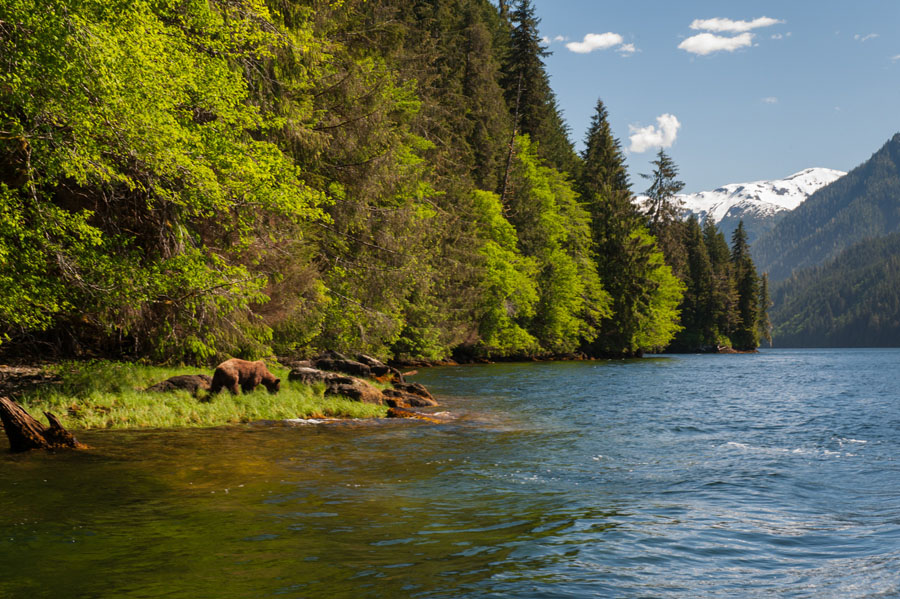The first sputtering of the de Havilland Beaver’s engine breaks the silence of the fog hovering over the rainforest surrounding the seaplane base in Prince Rupert, British Columbia. I wait on the dock with my gear as pilot Ken Cote ushers us onto the plane for our 25-minute flight into the Khutzeymateen Inlet. Once we are in the air, Ken begins to serenade us with Elvis songs and only breaks from it to point out a few features below, telling us stories from his thousands of flights over the area. He has been flying B.C.’s north coast for 48 years. He came to Prince Rupert in 1969 and never looked back. Ken tells us to keep our eyes open for mountain goats on the cliffs outside our windows—they had spotted some the previous day.
“There she is below, the Khutz Lodge,” Ken says over the headset, descending to land the pontoon plane on the ocean inlet as he has many times before. Khutzeymateen Wilderness Lodge owner and lead guide Jamie Hahn and his crew are there to meet us as Ken moors the plane to the dock adjacent to the floating lodge. People and supplies are unloaded and Ken pushes off and heads back to Prince Rupert.
The Khutzeymateen Wilderness Lodge is situated in the Khutzeymateen Grizzly Bear Sanctuary, 45 kilometres northeast of Prince Rupert. Accessible only by floatplane or boat, it is the sole accommodation available in the sanctuary (other than onboard a vessel).
Jamie Hahn worked for BC Parks for nearly 22 years. For 16 of those years, his position was the North Coast Area Supervisor. In that role, Jamie managed the Khutzeymateen Grizzly Bear Sanctuary. As a result, he knows the park and its residents intimately.
However, the many years of working within a bureaucracy took its toll on Jamie and he decided he needed a change. Jamie left his position at BC Parks in March of 2015. Soon after, he learned Greg Palmer was selling the lodge and its bear-viewing permit. Jamie thought this would be a great opportunity to put his experience and knowledge of the bears and the park to good use.
In September 2015, Jamie partnered with Joe Kotai to purchase the lodge. That winter was spent milling cedar at Joe’s sawmill and rebuilding the lodge from the floorboards up. Many of their friends volunteered hundreds of hours to get the lodge ready. After months of hard work and sleepless nights, the lodge was towed from Port Edward, 15 kilometres south of Prince Rupert, by tugboat and arrived in the Khutzeymateen the last week of April—just in time for the beginning of bear viewing season.
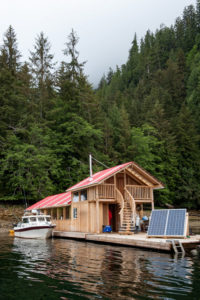
That first season went very well and kept Jamie busy finishing the lodge and guiding the many visitors who came to visit. The demand was so great that Jamie and Joe built another floating lodge this past winter to join onto the original. Now there is one lodge that accommodates guests and another for staff. It also provides an extra common room for guests to relax by the woodstove and take the north coast chill off, while taking in the views of the inlet. This is in addition to the common area in the original lodge where guests dine. This was completed just in time for their second season of operation, in April 2017, and once again towed out from Port Edward. Jamie says that as they turned the corner from Steamer Pass into the Khutzeymateen Inlet, it was like coming home for him.
The area really has that effect on a person. I have been there three times now as a photographer for magazine shoots and now to lead photo tours at the Khutz Lodge. Every time is more exciting than the last. On this most recent visit, I think of some of the bears that I have come to know, even if briefly, on the last trip. They have scars and markings that help to physically identify them. However, their personalities and characteristics have the true impact.
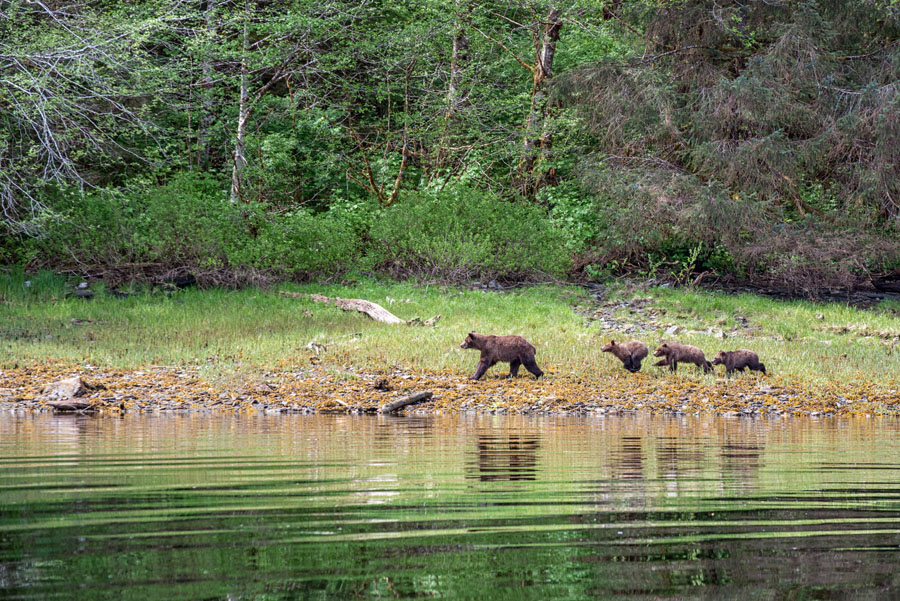
It was a young male grizzly from my visit in May 2016 that I am thinking about as I travel into the sanctuary this time. As you get to know them and identify the bears you end up naming them, which creates a connection. We named this young bear “Boo.”
Boo was approximately four years old and likely just out on his own away from his mother in 2016. He was quite comfortable with humans viewing him. He even came by the lodge at one point for a brief visit as he made his away along the shore. As I reunite with Jamie at the lodge, I immediately ask about Boo. Jamie says that he hasn’t been seen since midway through the season last year. It worries me a bit as Boo was also quite comfortable being around large males that may kill a smaller male, if the chance arose. It could also simply mean that he moved onto another area. Grizzlies can wander huge distances looking for food and their territory can be up to a few hundred square kilometres. I am hopeful we will see Boo again this year.
Bears like Boo can have the large home range here because of the provincial park. The 45,000 hectaresthat make up the Khutzeymateen Grizzly Bear Sanctuary is the only park of its kind in Canada. It was established in 1994 specifically to protect grizzly bears and their habitat.
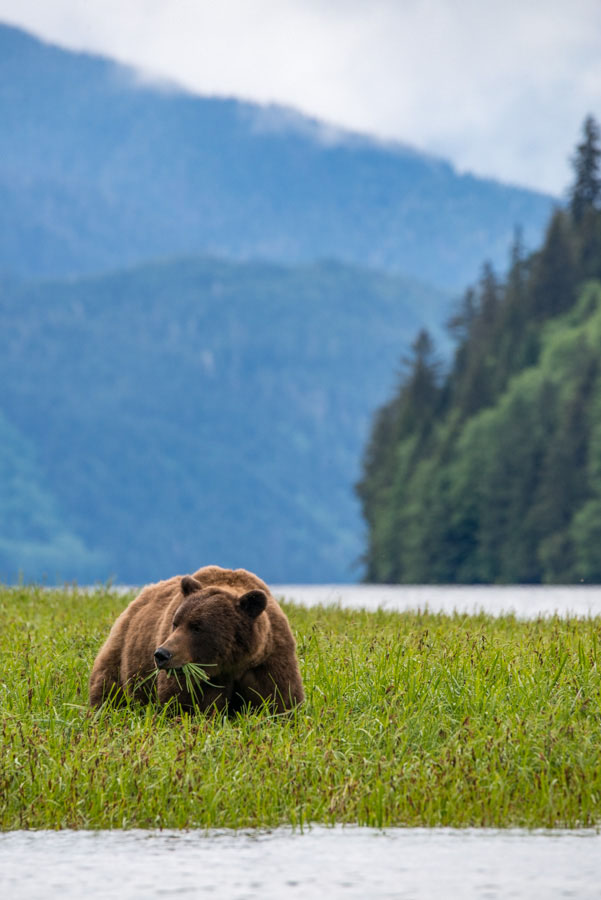
The bears congregate in the area, as there is an abundance of food available for them from the time they come out of hibernation in the spring until they return to their dens in the late autumn. Everything the bears need is here in Khutzeymateen.
In April, when they emerge from their long fast, they have lost a large percentage of their fat reserves and need to replenish them. The first food that is available in abundance to them is Lyngbye’s Sedge (Carex lyngbyei), which is common on the West Coast and grows in abundance in the salt marshes of Khutzeymateen Inlet. The sedge is very high in protein and at the peak of its growth can contain up to 28 percent protein. The bears mow it down as quickly as it grows. A grizzly can eat between 22 to 45 kilograms of sedges each day.
When the tides go out and reveal the mud flats, many bears will take a break from eating sedge to take in the bounty the ocean has to offer. Some bruins have learned from their mothers to deftly use their long claws to dig for clams or to search for other tasty morsels hidden under rocks and to pluck mussels off boulders.
Once the sedge goes to seed, it loses its nutritional value—and almost on cue the salmon begin to arrive. All five species of Pacific salmon come to the rivers and creeks of the Khutzeymateen Inlet to spawn. This is the real treasure the bears wait to find each year. The spring salmon are the first to arrive usually in late June and the other species will follow throughout the summer and into the autumn. Salmon supply the much-needed fat and protein for grizzlies to survive the long winter hibernation.
This excellent habitat in the park and protection from hunting in the areas surrounding the sanctuary results in approximately 60 grizzly bears residing within the Khutzeymateen. Jamie shares much of this information with guests as we prepare to board the covered Zodiac and head out in search of bears.
We make our way toward the head of the inlet scouring the shoreline through binoculars. We pay special attention at the mouths of creeks along the way, where there is an abundance of sedge. Darren Davies, a friend of Jamie’s who has been helping him with building and completing the lodge, is onboard with us. Darren points to a small bay where he thinks he sees a bear, so we slowly approach.
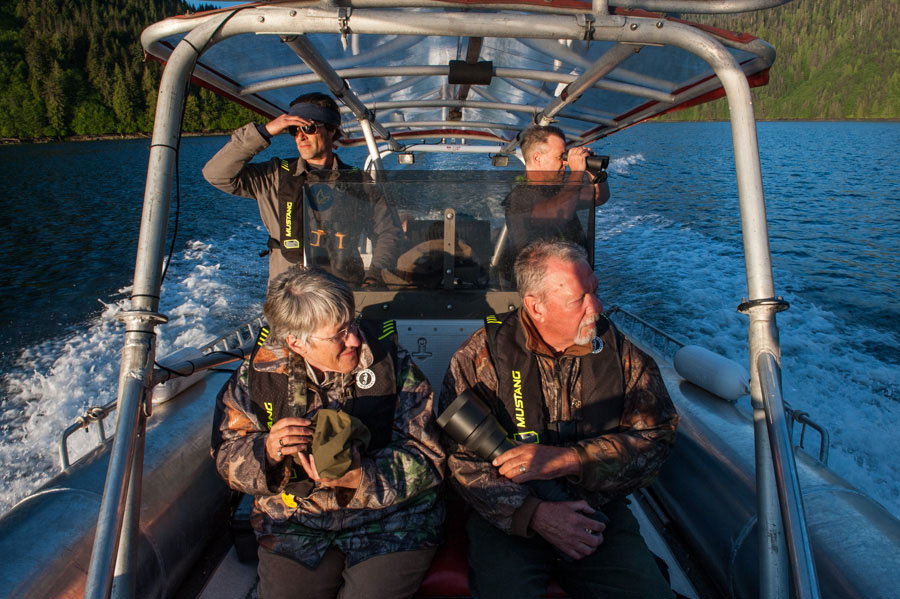
The guests with us are excited. Jamie, Darren and I keep looking through our binoculars and confirm there is definitely a bear. Actually, it is an even better start to the trip: there are two. May is mating season, so this could be a breeding couple, but these bears don’t look that old. Perhaps they are siblings that have reunited and are comfortable feeding close to each other.
The bears are at ease in our presence and we are close enough to start taking photographs. As we approach to see the bears clearly and get some close-up photos with our telephoto lenses, I begin to examine my images on the back of my screen. Darren does the same and says, “I think that’s Boo.” I was thinking the same thing but didn’t want to say anything yet. We both take a bit more time to look at some of the bear’s markings and observe his mannerisms. We are both confident it is him and Jamie agrees. We all give a big smile knowing that Boo has survived and is all grown up.
We take a bit more time to observe the bears feeding and then continue further up into the inlet. We stop at the floating lodge that is the BC Parks Ranger Station, where it is mandatory that all visitors check-in and learn about the park. Rangers Allen Maxwell and Norman Faithful are there to meet us as we pull up and they greet Jamie like an old friend. In fact, they are old friends as they worked together here for many years. Norm and Al both began working here in the sanctuary in 1994 when the park was first established. Jamie began working with them when he became the area supervisor, so there is a strong tie between them.
The park rangers share information about the sanctuary with the guests and answer questions. They also share information about the Tsimshian First Nation, as this is part of their traditional land. BC Parks and the Tsimshian First Nation jointly manage the sanctuary. Khutzeymateen (K’tzim-a-deen) is a Tsimshian word that seems to have two meanings: “Valley at the Head of the Inlet” or “Confined Space of Salmon and Bears.” Both are very fitting.
Al and Norm both come from the local village of Lax Kw’alaams (Port Simpson) and have a wealth of knowledge and many stories to share with visitors. They share information about bear activity they have seen and that has been reported to them. A mother and three cubs have been spotted over at Cedar Creek, so we decide to head out to look for them. This is early for a mother and cubs, as they normally don’t come out until later in June after mating season. Big boars are a great danger to cubs. But sure enough as we come around the corner, there they are—a mother and her two-year-old cubs feeding. This is a tremendous treat and a joy to observe. She keeps a close eye out and smells the air for other bears. After we observe and photograph for a short while she detects something and puts her cubs on the run and brings them into the cover of the forest.
We head back to the lodge where we get out of our wet clothes and warm up by the wood stove. Sitting around the long dining table we discuss the day’s events and celebrate the return of Boo with a glass of wine. Resident Red Seal Chef Andy Versluis lays out a feed of freshly caught spotted prawns and Dungeness crab for us. After dinner and lots of socializing the crew starts to get chores done in preparation for the next day. Guests retire and go to sleep with the quiet stillness of the Great Bear Rainforest. It has been a good day; one of several to come.
On the last evening before I depart I am in my room uploading photos and cleaning my camera equipment when someone yells out from the deck: “Orcas”!
Megan Baker yells out to the guests and myself “Do you want to go out on the boat to see them?” I quickly wrangle my equipment together, throw on a lifejacket and I’m on the boat before everyone else as I am unable to contain my excitement.
Once out on the water, we spot the pod and keep back and out of their travel path, making sure not to disturb them. Megan starts to point out the family members as they make their way towards the head of the inlet. Jamie hired Megan this season to be a second guide and to help around the lodge. She has worked in marine and whale conservation for many years on BC’s coast. This is her specialty and you can see and hear the exuberance as she points out the features and behaviour of the pod.
There are three females that swim closely to the shore on the right. A large male along with a calf that still has some orange colouring keeps close to the larger male while they traverse the left side of the inlet. Another male trails behind coming down the middle of the inlet. There are six whales in total in the pod and they are feeding on something. At this time of year, it is most likely chinook salmon.
There is a tour boat filled with guests that has come into the inlet from Prince Rupert on a day tour to see grizzly bears. The pod of orcas weaves around their vessel and the guests snap pictures of them from the deck. I wonder if they realize just how fortunate they are to get to see bears and orcas up close on such a short trip. Even though it is raining and in my I haste haven’t dressed warmly enough or put my waterproof boots on before getting onboard, I am reluctant to go back to the lodge as I know these opportunities don’t come along too often. Besides, we know there is another delicious feed awaiting us, along with warm fire and a glass of wine.
On my final day, I begin packing up my gear and think to myself that I am not ready to leave, wishing I could stay much longer. I bring my gear down to the dock where the float plane ties up and keep my eye on the horizon. The weather has closed in and the mountains of the inlet make themselves briefly visible between the thick and slow-moving clouds. I wonder if the visibility is too poor for the plane to make it in to collect us. This is more wishful thinking than anything. After flying in this area for 48 years, Ken Cote knows every inch of the surrounding terrain and shoreline. Sure enough, a few minutes later the sound of the Beaver breaks through the thick muffling clouds and Ken lands out front and pulls up to the lodge.
The other departing guests and I say our goodbyes to the crew and load our gear onto the plane. As quickly as he arrived, Cote jumps into the captain’s seat and Jamie pushes us away from the dock and waves with a smile. I put on my headset as the engine sputters and we taxi across the water away from the lodge for takeoff. I stare out through the rain-speckled window at the lodge and mumble into the microphone saying a goodbye to the Khutz Lodge and saying I miss it already. Ken says through the headset, “Don’t worry; you’ll be back.”
He’s right.
